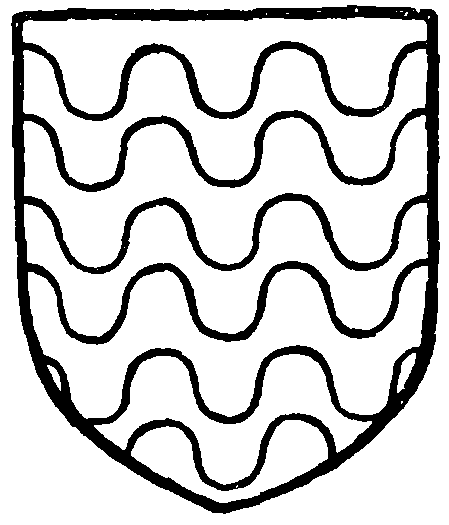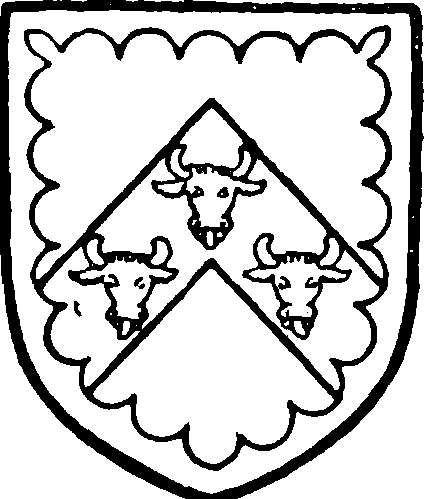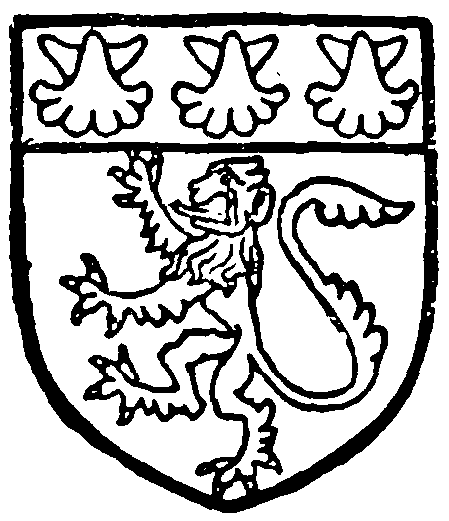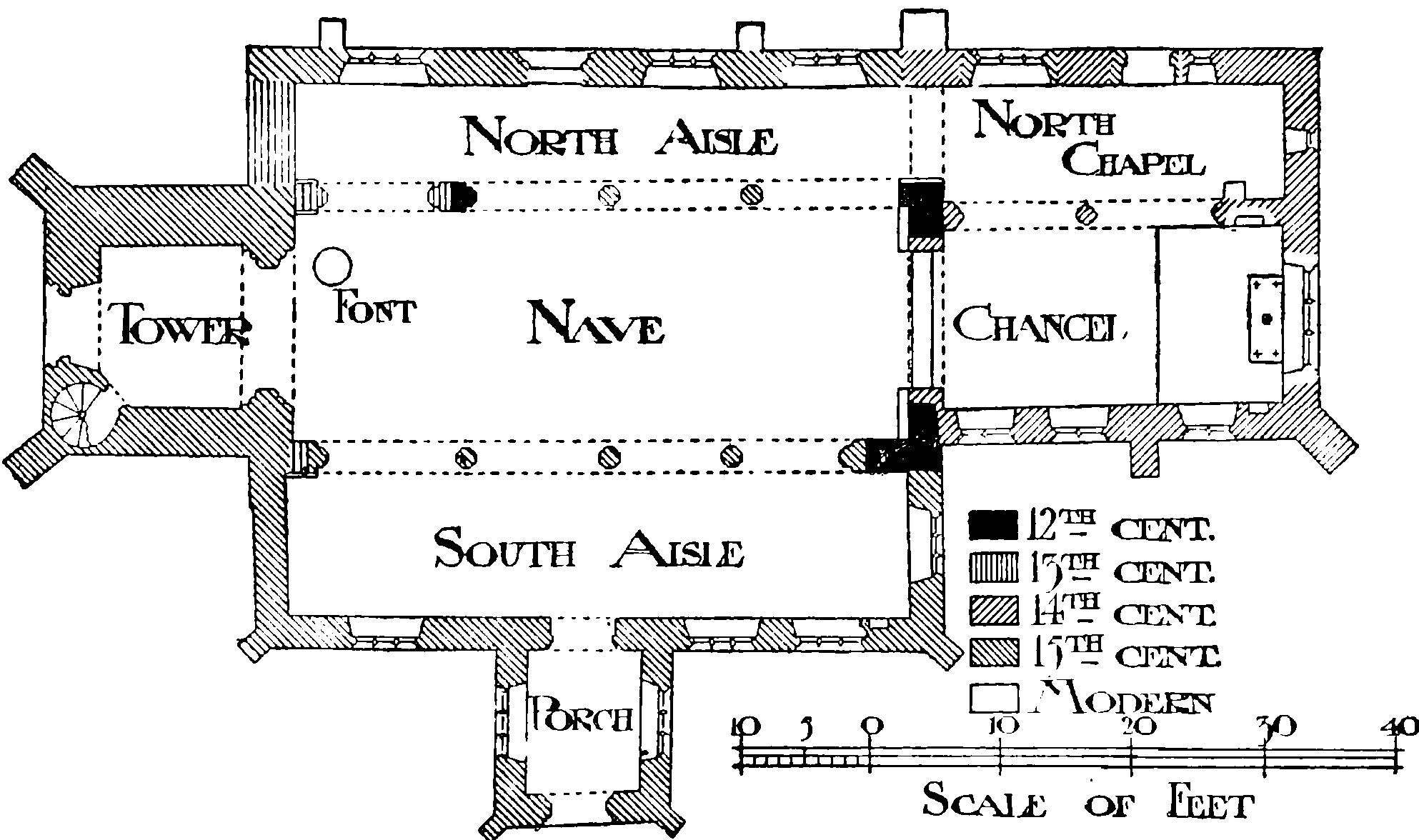A History of the County of Bedford: Volume 3. Originally published by Victoria County History, London, 1912.
This free content was digitised by double rekeying. All rights reserved.
'Parishes: Eversholt', in A History of the County of Bedford: Volume 3, ed. William Page (London, 1912), British History Online https://prod.british-history.ac.uk/vch/beds/vol3/pp375-378 [accessed 19 April 2025].
'Parishes: Eversholt', in A History of the County of Bedford: Volume 3. Edited by William Page (London, 1912), British History Online, accessed April 19, 2025, https://prod.british-history.ac.uk/vch/beds/vol3/pp375-378.
"Parishes: Eversholt". A History of the County of Bedford: Volume 3. Ed. William Page (London, 1912), British History Online. Web. 19 April 2025. https://prod.british-history.ac.uk/vch/beds/vol3/pp375-378.
In this section
EVERSHOLT
Evereshot (xi cent.); Eversolt (xii cent.); Evereshout, Evereshawe (xiii cent.).
The parish of Eversholt, covering an area of 2,145½ acres, contains no village proper, but consists of several clusters of houses called Church End, Brook End, Wits End, Higher and Lower Rads End, Water End, Higher and Lower Berry End, Hills End and Tyrells End, connected by a system of roads. The land rises gradually from the east, where the height is approximately 300 ft., to the west, where at Hills End and a little further north at Higher Berry End it reaches over 400 ft. above the ordnance datum.
The soil is loam and gravel with a clay subsoil, and yields crops of wheat, barley, oats, beans and peas. The land, however, is chiefly pasture; there are 1,298½ acres of permanent grass, 656 acres of arable land and 191 acres of woods and plantations. (fn. 1)
Part of Woburn Park stretches into this parish near Berry End, and is there known as Hay Wood and Wall Close.
The church of St. John the Baptist and the schools are in the south at Church End. The present rectory and Church End Farm are fine Georgian houses of gauged brickwork. The old rectory and glebe-lands to the north of the church have now been absorbed in Woburn Park.
The building at present known as Mill Farm, about half a mile south-east of Church End, was erected in 1851. About thirty years ago the farm was renamed, having been known previously to that time as the Model Farm, and before that as 'The Isles.' A hill to the south of the village is still known as Mill Hill; a windmill is said to have existed here, though not within living memory.
Wakes End Farm in the north, between Birchall's Wood and Briars Stockings Copse, is probably the site of the 16th-century manor of Wakes, and traces of a moat around it still remain.
There is a small Methodist chapel at Wits End, and at Tyrells End is a parish reading-room.
In the manuscript memoirs of a Mr. Cole, now preserved at the British Museum, is an account of his visit to Mr. Reddall of Eversholt in 1767, with the following description: 'The house, grounds and fish-ponds are singularly neat and elegant. He has such an abundance of water, and that contrived so artfully, that you may see two pretty cascades from the windows, and what is more singular, his kitchenjack is turned by an overshot watermill.' Mr. Reddall's family was settled at Eversholt during the 17th and 18th centuries, (fn. 2) and appears to have had property at Wakes, (fn. 3) where the above-described house was probably situated.
The inclosure of Eversholt was made by an Act of Parliament passed in 1806, (fn. 4) and the award is now in the church.
MANORS
At the time of the Domesday Survey EVERSHOLT MANOR, which was 7½ hides in extent and formerly held by Turgis, a thegn, belonged to Hugh de Beauchamp, (fn. 5) whose fief was subsequently known as the barony of Bedford. The owners of the barony continued as overlords until the middle of the 13th century, (fn. 6) when William de Beauchamp renounced all claim to feudal service due from Eversholt Manor, which had been granted by the tenant in fee, to Woburn Abbey. (fn. 7) A similar ceding of rights was made in 1313 by Elizabeth daughter of Baldwin de Wake and Ela his wife, a co-heir of the Beauchamps, who quitclaimed to the monks of Woburn any services due from them for lands held of her in fee in Eversholt. (fn. 8)

Woburn Abbey. Azure three bars wavy argent.
A certain Ralph held the manor as tenant in fee in 1086. (fn. 9) At the close of the 12th century a family named Eversholt were settled here, (fn. 10) and it is probable they were then in possession of the manor. John son of Miles de Eversholt, who dealt with lands here in 1202–3, (fn. 11) held Eversholt by service of one knight's fee of the Bedford barony early in the 13th century, (fn. 12) and before 1240 alienated the same to the abbot and convent of Woburn. (fn. 13) This monastery had already acquired other possessions in this parish, (fn. 14) and later increased their lands in the same place by numerous small grants. In 1284 they received one messuage and 30 acres of land from Paulinus de Eversholt, (fn. 15) and in the same year a rent of 24s. 0½d. from Hugh de Mentmore. (fn. 16) Further alienations in mortmain were made to the abbey by John son of Richard Knight in 1291, (fn. 17) by Ralph Botte and John de Staunton in 1307, (fn. 18) by John atte Forde in 1353, (fn. 19) and by Gilbert Archer in 1392. (fn. 20)
At the Dissolution the manor of Eversholt, valued at £31 6s., (fn. 21) fell to the Crown and was annexed to the honour of Ampthill, (fn. 22) and in 1550 was granted to the Princess Elizabeth for life. (fn. 23) In 1574 it was leased by her to George Bredyman for sixty years at a rent of £31 11s. 5d., but in 1601 it was again in the hands of the Crown, and was purchased by Henry Astrey for £1,578 10s. 10d., the manor to be held in chief by the service of one-fortieth part of one knight's fee. (fn. 24)
Before 1613, however, it had passed to Thomas Hillersdon, kt., (fn. 25) and on his death in 1623 descended to his son and heir Thomas, then a minor aged twelve. (fn. 26) He survived his father nine years and left the estates to his infant son, another Thomas, (fn. 27) who in 1651 married Elizabeth daughter of John Huxley of Edmonton, on whom an annuity of £350 chargeable on Eversholt and his other Bedfordshire properties was settled as jointure. (fn. 28)

Hillersdon. Argent a cheveron and an engrailed border sable with three bulls' heads caboshed argent on the cheveron.
Their son and heir Thomas was in possession in 1676–7, (fn. 29) and William Hillersdon, a son of this Thomas, (fn. 30) suffered a recovery of the property in 1699. (fn. 31) Three years later he conveyed it to Wriothesley Duke of Bedford for £3,901 6s. 6d., (fn. 32) with whose direct descendants the manors of Eversholt and Wakes have since remained, both now belonging to the present Duke of Bedford.
The first mention of the rectory manor of EVERSHOLT occurs in 1331, when John rector of the church there gave half a mark for confirmation of his rights to waifs and strays, view of frankpledge, assize of bread and ale, from his tenants in Eversholt, which his predecessors had claimed from time immemorial. (fn. 33)
The rectory manor belonged to successive rectors appointed by the Knights of St. John until the Dissolution, when it with the advowson lapsed to the Crown.
In 1540 Sir Richard Longe received a royal grant of the lands and possessions of the Hospitallers' preceptory at Shingay, which included their property in Eversholt. (fn. 34) He settled his estates on his son Henry on his marriage with Dorothy daughter of Nicholas Clark, and Henry on his death in 1573 (fn. 35) left them by will to his wife and daughter Elizabeth. (fn. 36) The latter afterwards married Sir William Russell, (fn. 37) and they made a settlement of Eversholt Manor in 1594. (fn. 38) Elizabeth died in 1611, leaving as heir a son Francis, (fn. 39) but her mother Dorothy, who had married Sir Charles Morrison (fn. 40) and survived her, apparently held Eversholt as dower for life, and was seised the following year when she settled it upon her son by her third husband, Sir Charles Morrison, (fn. 41) to the exclusion of the heirs of her daughter. Sir Charles Morrison obtained a release of a third part of all the manors held by his late mother in dower in 1620, (fn. 42) but the fourth Earl of Bedford, son of Elizabeth Russell, appears to have contested the claim of the Morrisons successfully, and in 1649 Eversholt rectory, manor and advowson were in the hands of his third son John. (fn. 43) He was succeeded by his younger brother Edward, whose son William died unmarried, leaving his estates to his brother Edward, who held Eversholt in 1689. (fn. 44) The latter was created Earl of Orford in 1697, but on his death without issue in 1727 Anne widow of Sir Thomas Tipping and daughter of his sister Letitia was found to be his heir. On her death without male issue Eversholt Manor appears to have descended to her elder daughter Letitia wife of Samuel first Lord Sandys, (fn. 45) on whose son Edwin it was settled in 1768. (fn. 46) He, who died in 1797, left the reversion of his estates, after the decease of his widow Anne, to the second son of the Marquess of Downshire. Anne Baroness Sandys (fn. 47) died in 1806, and Eversholt rectory manor and advowson were purchased in 1839 from Lord Sandys' trustees by the Duke of Bedford. (fn. 48)

Russell. Argent a lion gules and a chief sable with three scallops argent therein.
One hide of land in Eversholt at the time of the Domesday Survey was held of the Bishop of Bayeux's fief by Ansgot of Rochester. (fn. 49)
The lands of the bishop soon escheated to the Crown, (fn. 50) and no record is found of Ansgot or his heirs holding lands in Eversholt after this date. In the early 13th century the overlordship of this property was apparently annexed to the honour of Aubervill, held by William de Aubervill. (fn. 51) In 1276 and 1284–6, however, it belonged with many of the Bayeux escheated lands to the barony of Rochester, and the tenant in fee, Richard de Eversholt, who earlier held this hide of land of the Aubervill honour, had given place to John de Eversholt. (fn. 52) The subsequent history of this property is obscure, but since it comprised lands in Eversholt and Milton Bryant (fn. 53) it may possibly be coincident with the estate in those places granted to Woburn Abbey by John son of Richard Knight of Eversholt in 1291. (fn. 54)
Among the lands of the reeves and almsmen of the king in 1086 is a third estate in Eversholt, consisting of half a hide which Herbert, a king's bailiff, held in the king's service. (fn. 55)
In 1204–5 William de Leicester received a grant of 1 virgate of land in Eversholt valued at 4s. yearly, (fn. 56) and his descendant, another William of Leicester, held the same in 1276, paying to the king an annual rent of 4s. (fn. 57) No direct descent can be traced for this small holding, but the lands held by John de Grey in the vill of Eversholt in 1316 (fn. 58) may represent the half hide held by the king's bailiff at Domesday. The Greys retained a certain property in Eversholt, consisting of lands from which rents were due to them, up to the middle of the 16th century, (fn. 59) the last record of this family in connexion with Eversholt occurring in 1545, when Lord Grey of Wilton owed certain services to the king at his court baron in the manor of Eversholt for lands there held in chief. (fn. 60)
Record of a so-called manor of WAKES, in the parish of Eversholt, occurs in 1502, when it was held by John Lee and Katherine his wife in right of the latter, and by them conveyed to Thomas Langston. (fn. 61) In 1560 it is found in the hands of Walter Hinton, (fn. 62) and in the same year it was settled upon Thomas his son, (fn. 63) who in 1599 conveyed it to Richard Charnock. (fn. 64) Prior to 1613, however, it had passed to Sir Thomas Hillersdon, kt., and its further history is identical with Hillersdon's manor of Eversholt (q.v.).
Among the temporalities of the priory of Caldwell in 1291 was a rent from lands in Eversholt, (fn. 65) which in 1535 were valued at 9s. 8d. (fn. 66) In the register of the subsequent sale of the priory lands these lands are described as one close called Punters Stockings, containing about 9 acres of arable land, between the estates of Peter Grey and Thomas Hinton, yielding 3s. yearly. (fn. 67)
The priory of Dunstable, which received a grant of lands in Eversholt from Arnold son of Ernest and Felicia his wife in 1219, (fn. 68) is returned as part holder of Eversholt vill in 1316. (fn. 69) No further mention of lands held by this religious house occurs, and at the time of the Dissolution the return of the priory lands includes no possessions in Eversholt.
CHURCH
The church of ST. JOHN THE BAPTIST consist of a chancel with a north chapel, part of which is now used as a vestry, a nave with north and south aisles, and a west tower. The earliest work is in the north arcade of the nave, of which all but the western bay originally dated from c. 1180; the western bay, c. 1230, witnesses to a lengthening of the nave and aisle at that date, while the chancel was rebuilt c. 1330, with the addition of a north chapel. In the 15th century the tower was built, and the south aisle was added soon after the tower. The nave clearstory is of this period, and the three east bays of the north arcade were then rebuilt, re-using the responds at either end. In 1864 the church was restored by Sir Gilbert Scott.
The east window of the chancel is modern, of three trefoiled lights. On the south side are three pointed 14th-century windows of two cinquefoiled lights with flowing tracery, much repaired; the west window is lower than the others and divided by a transom to form a low side window. There is a cinquefoiled ogee-headed piscina with a label terminating in foliage, and with a crocketed pinnacle, and opposite in the north wall is a modern copy of it. On the north side is a 14th-century arcade of two bays, resting on a pier formed of four shafts separated by rolls, with moulded capitals and bases; the arches are in two wave-moulded orders. The chancel arch is of the same date, springing from jambs which become thicker below the springing, suggesting that the lower part of the wall may be 12th-century work.
The nave has a north arcade of four bays, between the third and fourth of which is a strip of walling; the first three arches are 15th-century work moulded in two orders, the shafts being octagonal with capitals and bases of the same date; there is a late 12th-century scalloped corbel at the east end, whilst the respond supporting the third bay is of the same date with leaf ornament. The west bay is in two chamfered orders on responds having half-round shafts with 13th-century moulded capitals and bases.
The south arcade is in four 15th-century bays, with arches like those opposite, octagonal shafts and moulded capitals and bases. The clearstory windows, four on each side, are like those in the aisles. The tower arch is in three chamfered orders with 15thcentury capitals and bases.
The north aisle has three restored three-light windows on the north, and the doorway, also restored, is pointed with two continuous wave-moulded orders. The chapel has a north window like those in the aisle, but modern and narrow square-headed vestry windows in the east and north walls; the doorway is of the 15th century, and there is a 15th-century piscina. The aisle roof is 15th-century work with simply-carved bosses.
The south aisle has windows like those in the north aisle and a 15th-century piscina, and the porch, which is of the same date, has similar windows at the sides; the outer arch of the porch is fourcentred under a square head, the spandrels having carved foliage. The aisle has a 15th-century roof with well-carved bosses.
The tower is of sandstone roughly coursed, and is in three stages, with an embattled parapet, moulded plinth and diagonal buttresses; the west doorway is of two moulded orders separated by a casement. The belfry windows are of two cinquefoiled lights with tracery under a pointed head. The west window, mostly modern, is like them.
The font is of the 13th century, with a cylindrical bowl resting on a central and four detached shafts.
There are no monuments of interest, but part of a brass, c. 1450, with effigies of six sons was discovered in 1864, and is now on the south wall of the chancel.

Plan of Eversholt Church
There are six bells: the first and fourth by Miles Graye of Colchester, 1638; the second and sixth by Taylor of Loughborough, 1882; the third and fifth by William Emerton of Wootton, 1789 and 1786.
The plate consists of a chalice with date mark 1688–9 and maker's mark I. F. and a late Victorian paten.
The registers begin as follows: baptisms 1628, burials 1631, and marriages 1630.
ADVOWSON
The earliest record of a church at Eversholt occurs in 1247, when the advowson of the rectory belonged to the Prior of St. John of Jerusalem in England. (fn. 70) His successors evidently continued as patrons until the Dissolution, at which date the prior through the commandery of Shingay received an ancient pension of 2s. from the rectory of Eversholt, then valued at £16 11s. 6d. (fn. 71) The subsequent history of the advowson is identical with that of the rectory manor (q.v.).
The foundation grant to Newnham Priory by Simon de Beauchamp in 1166 included two parts of the tithes of the rectory of Eversholt, (fn. 72) the portion of the priory in 1291 being assessed at £1 6s. 8d. (fn. 73) This portion apparently decreased in value, however, for at the time of the Dissolution it only amounted to 14s. (fn. 74)
CHARITIES
The Town Estate or Parochial Charity, the origin of which is unknown, consists of the Town Farm, containing 85 acres or thereabouts, the Green Man Inn, and 4 acres of meadow, eleven cottages, and 17 acres or thereabouts of allotments, acquired on the inclosure in 1808, producing a gross rental of about £225 a year. The charity is regulated by schemes of the Charity Commissioners of 19 February 1878 and 14 January 1887, whereby one-third of the net income is made applicable for (a) church purposes, (b) relief of poor, and (c) for educational purposes respectively.
In 1907 the sum of £50 was allocated for each of these objects, the educational share being applied in money prizes to school children varying from 2s. 6d. to 13s. each, and £1 19s. to the lending library. The reserve fund under the scheme amounted to £132.